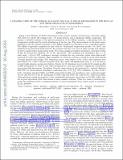| dc.contributor.author | Humphrey, Philip J. | |
| dc.contributor.author | Buote, David A. | |
| dc.contributor.author | Canizares, Claude R. | |
| dc.date.accessioned | 2012-08-02T20:02:07Z | |
| dc.date.available | 2012-08-02T20:02:07Z | |
| dc.date.issued | 2004 | |
| dc.date.submitted | 2004-06 | |
| dc.identifier.issn | 0004-637X | |
| dc.identifier.issn | 1538-4357 | |
| dc.identifier.uri | http://hdl.handle.net/1721.1/71965 | |
| dc.description.abstract | Using a new Chandra ACIS-S3 observation of the normal, isolated, moderate-L[subscript X] lenticular galaxy NGC 1332, we resolve the emission into ~75 point sources and a significant diffuse component. We present a detailed analysis of the spectral properties of the diffuse emission, constraining both the temperature profile and the metal abundances in the hot gas. The characteristics of the point-source population and the spatial properties of the diffuse emission are discussed in two companion papers. The diffuse component comprises hot gas with an ~isothermal temperature profile (~0.5 keV) and emission from unresolved point sources. In contrast with the cool cores of many groups and clusters, we find a small central temperature peak. We obtain emission-weighted abundance constraints within 20 kpc for several key elements: Fe, O, Ne, Mg, and Si. The measured iron abundance (Z[subscript Fe] = 1.1 in solar units; >0.53 at 99% confidence) strongly excludes the very subsolar values often historically reported for early-type galaxies. This continues, in a lower LX system, a trend in recent observations of bright galaxies and groups. The abundance ratios, with respect to Fe, of the other elements were also found to be ~solar, with the exception of Z[subscript O]/Z[subscript Fe], which was significantly lower (<0.4), as seen in several bright galaxies, groups, and clusters. Such a low O abundance is not predicted by simple models of ISM enrichment by Type Ia and Type II supernovae (SNe) and may indicate a significant contribution from primordial hypernovae. Revisiting Chandra observations of the moderate-LX, isolated elliptical galaxy NGC 720, we obtain similar abundance constraints (Z[subscript Fe] = 0.71 [+0.40 over -0.21], 90% confidence; ZO/ZFe = 0.23 ± 0.21). Adopting standard SNe Ia and SNe II metal yield models, our abundance ratio constraints imply that 73% ± 5% and 85% ± 6% of the Fe enrichment in NGC 1332 and NGC 720, respectively, arises from SNe Ia. Although these results are sensitive to the considerable systematic uncertainty in the SNe yields, they are in good agreement with observations of more massive systems. These two cases of moderate-[subscript LX] early-type galaxies reveal a consistent pattern of metal enrichment from cluster scales to moderate [subscript LX/LB] galaxies. | en_US |
| dc.language.iso | en_US | |
| dc.publisher | IOP Publishing | en_US |
| dc.relation.isversionof | http://dx.doi.org/10.1086/425413 | en_US |
| dc.rights | Article is made available in accordance with the publisher's policy and may be subject to US copyright law. Please refer to the publisher's site for terms of use. | en_US |
| dc.source | arVix | en_US |
| dc.title | A Chandra View of the Normal SO Galaxy NGC 1332: II: Solar Abundances in the Hot Gas and Implications for SN Enrichment | en_US |
| dc.type | Article | en_US |
| dc.identifier.citation | Humphrey, Philip J., David A. Buote, and Claude R. Canizares. “A Chandra View of the Normal S0 Galaxy NGC 1332. II. Solar Abundances in the Hot Gas and Implications for Supernova Enrichment.” The Astrophysical Journal 617.2 (2004): 1047–1058. | en_US |
| dc.contributor.department | MIT Kavli Institute for Astrophysics and Space Research | en_US |
| dc.contributor.approver | Canizares, Claude R. | |
| dc.contributor.mitauthor | Canizares, Claude R. | |
| dc.relation.journal | Astrophysical Journal | en_US |
| dc.eprint.version | Author's final manuscript | en_US |
| dc.type.uri | http://purl.org/eprint/type/JournalArticle | en_US |
| eprint.status | http://purl.org/eprint/status/PeerReviewed | en_US |
| dspace.orderedauthors | Humphrey, Philip J.; Buote, David A.; Canizares, Claude R. | en |
| dc.identifier.orcid | https://orcid.org/0000-0002-5769-8441 | |
| mit.license | PUBLISHER_POLICY | en_US |
| mit.metadata.status | Complete | |
